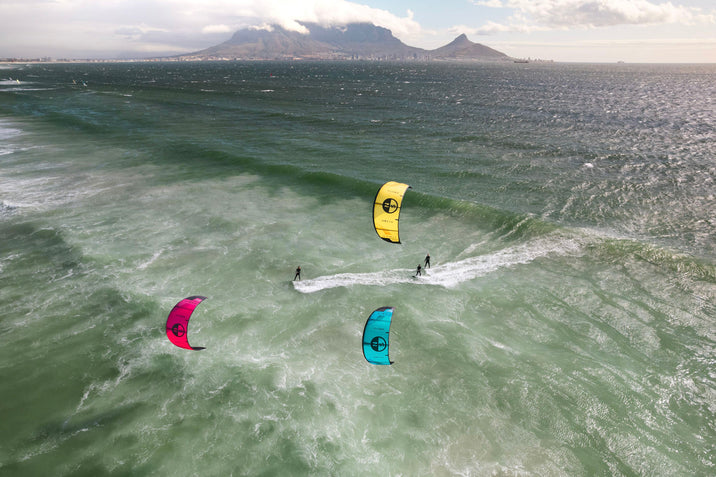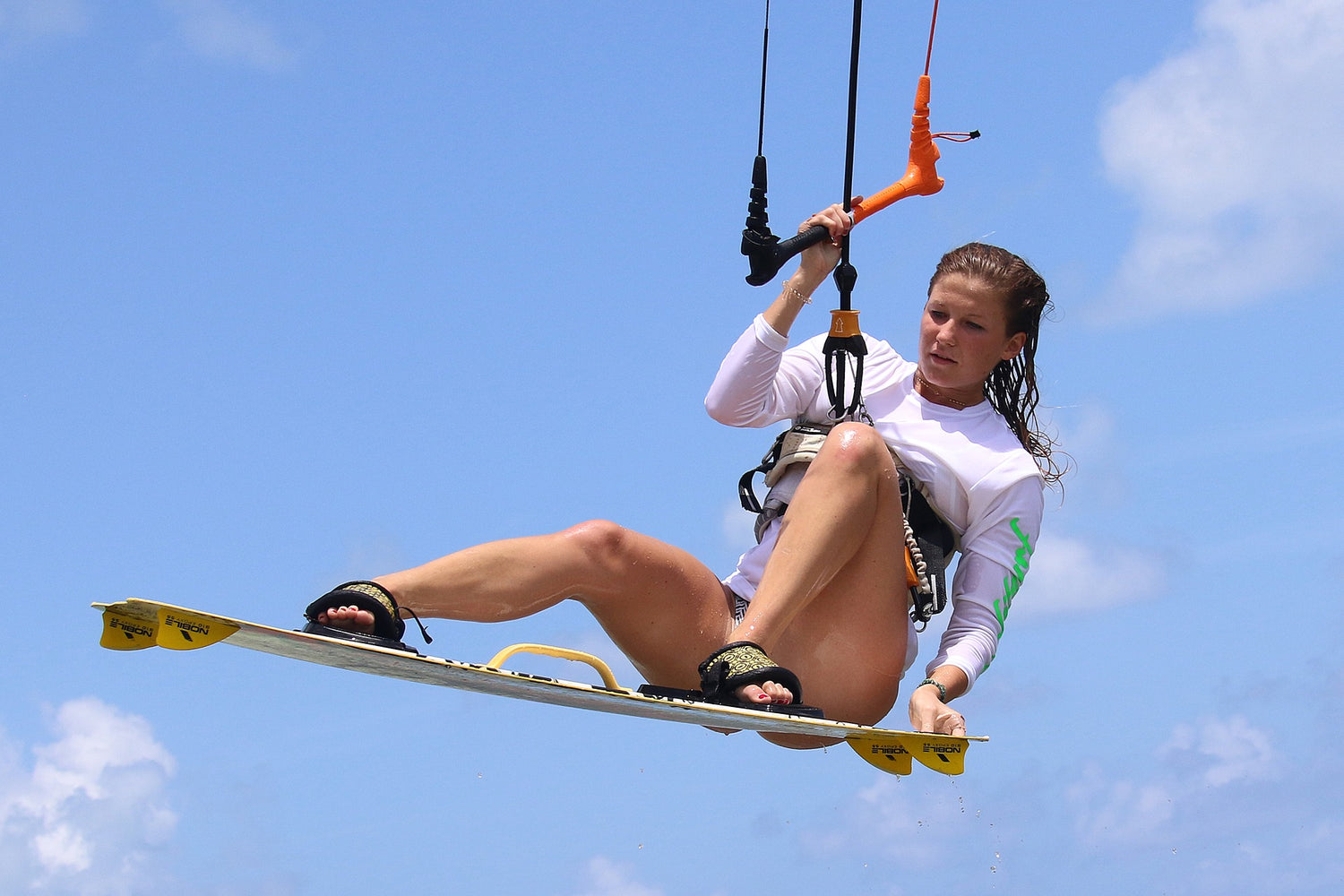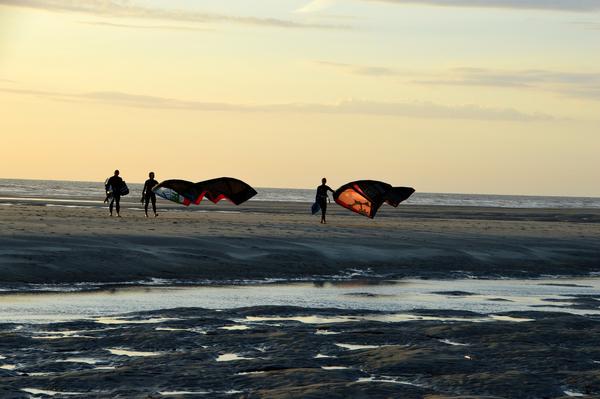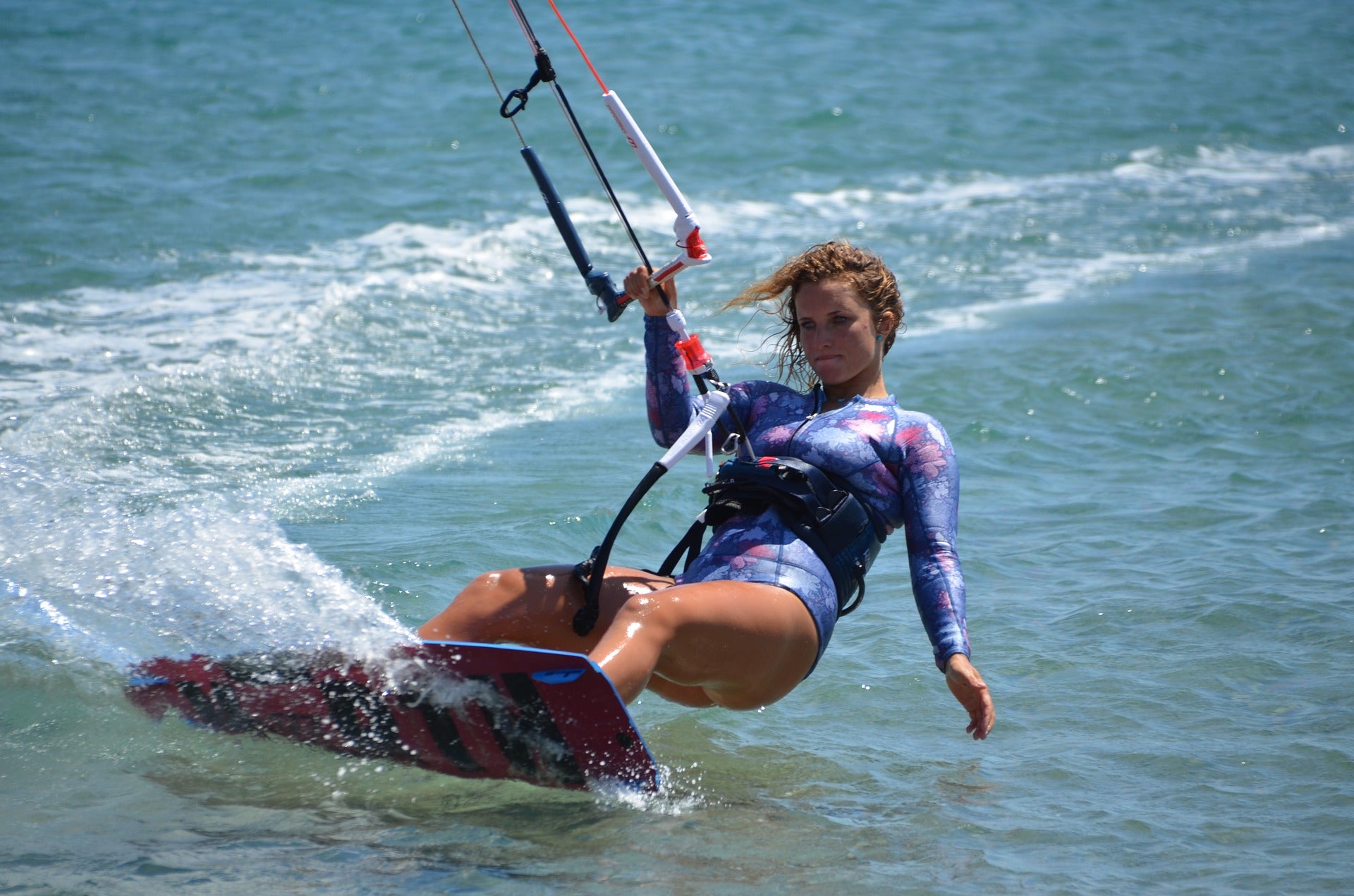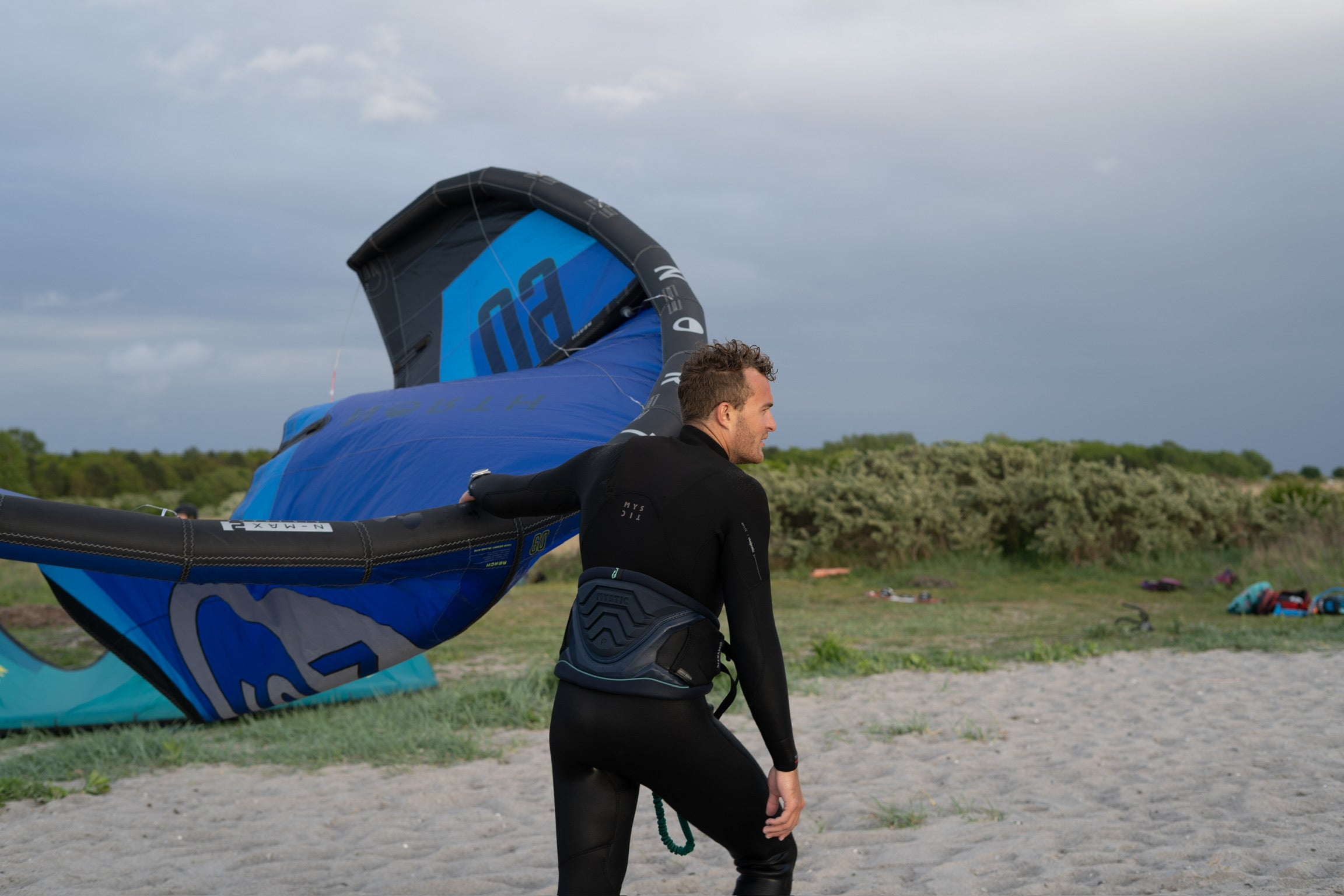Did you find this blog post helpful? Please like and share it with your friends.
Kitesurfing is one of the most exciting water sports out there. But how do you get started as a beginner? Where can you learn to kitesurf? How long does it take to learn? It is dangerous? This guide will take you through the most frequently asked questions about kitesurfing. Christian Leth and Tobias Mårtensson, who are both kitesurf instructors at Frozen Palm Tree (kitesurf school in Denmark), will give good advice through the guide. Follow this guide and you'll look like a pro in no time!
See: “This is kitesurfing” as an inspiration for the sport
Kitesurfing for beginners:
A complete guide for you as a new kitesurfer.
- What is kitesurfing?
- Is kitesurfing difficult?
- Is kitesurfing safe?
- What are the dangers of kitesurfing and how can I avoid them?
- Is kitesurfing easy to learn?
- What skills do you need to kitesurf?
- Do you have to be in good shape to learn to kitesurf?
- How old do you have to be to learn to kitesurf?
- Should I take a kite course?
- How long does it take to learn to kitesurf?
- Should I take private lessons or group lessons?
- How many course hours do I need before I can kitesurf myself?
- What should I look for in relation to kite schools and instructors?
- What will I learn on a kite course?
- Can kitesurf instruction videos and books replace a real kite course?
- When should I buy my own kite equipment?
- Can I buy used kite equipment?
- Do I need to be approved to surf without an instructor?
- Should I kitesurf with others or alone?
- What kitesurfing styles are there?
- How to learn to read the weather forecast for kitesurfing
Conclusion
1. What is kitesurfing?
First, what is kitesurfing? Kitesurfing is a water sport that has elements from wakeboarding, windsurfing and paragliding combined into one sport. The kitesurfer uses a kite and a board to surf the water. All you need is wind and water, which means you can sail in lagoons or on the sea. There is no need to be waves, although you can. But we are beginners and we have to start quietly.
Many beginners often ask: is there a difference between kitesurfing and kiteboarding? The answer is no. K itesurfing and kiteboarding are synonyms that refer to the same sport. In this guide we will refer to the sport as kitesurfing.

There are many different styles of kitesurfing (see question 20). You can develop quickly once you have mastered the basics. Like surfing without an instructor and sailing upwind, after that you will learn to jump and try your hand at some tricks, but that will happen. Later, you may want to focus on a certain style, eg wave surfing, speed racing or wakestyle. We will get into the different styles in this blog.
Typically, beginners start with freeride, which is also the most popular category.
2. Is kitesurfing difficult?
3. Is kitesurfing safe?
Kitesurfing is getting safer every year. Kitesurf equipment has become much safer than before. Today, all kites have a safety system as standard. For example, you can depower your kite if necessary. Therefore, use the latest gear you can afford to ensure yourself a good experience and take a course. Without a course, kitesurfing can become dangerous for yourself and others.

4. What are the dangers of kitesurfing and how can I avoid them?
The biggest danger will be yourself if you go kitesurfing on your own without having taken a kite course. You will not only be a danger to yourself, but also to everyone else around you . In addition, there are other things that can go wrong. For example, using old equipment that is in poor condition, not knowing the yield rules, not paying attention to your surroundings, panicking if something goes wrong and not knowing how to do a self-rescue.
5. Is kitesurfing easy to learn?
There is a general agreement, confirmed by Christian Leth and Tobias Mårtensson, that kitesurfing is one of the easiest surf sports to learn . Of course, you have to put in the effort, especially on your beginner's course, as there is no one to do it for you. However, you should be able to kitesurf on your own after a course of between 6 and 15 hours . Through your course, you will experience that you develop quickly and this will certainly help to give you a taste for the sport.
See all our kitesurfing courses here.
6. What skills do you need to kitesurf?
Those who want to learn to kitesurf are often completely new to water sports. Therefore, the lessons start from the beginning, unless you have any water or board sports experience. This means that kitesurfing does not require any special skills on your part . However, for safety's sake, it would be a good idea to be able to swim. "you must be able to swim if you are going out in deep water," says Christian Leth, he also adds that "if you have previously practiced board sports or sailing, it will make it easier to learn kitesurfing, but it is not a requirement ”.

7. Do you have to be in shape to kitesurf?
You don't need to be in good shape to learn to kitesurf. Kitesurfing is mostly about coordination and not your strength. Your kitesurfing gear is light and the pull from the kite comes through your trapeze. Which means you don't need to be a bodybuilder to control the kite. In fact, children as young as 7 can start kitesurfing . If you're lucky, you might see a 77-year-old kitesurfer. You will be able to see kite surfers surfing for hours if they are into the sport. Tobias Mårtensson says "Now you're in better shape, now the sport will also be easier for you." He adds “Kitesurfing will get you in shape”. One whose form will certainly help you with your development and prevent injuries. The last thing you want is to get injured early in your kitesurfing career.
8. How old do I have to be to kitesurf?
There is no age limit for kitesurfing. Therefore, when you are on the spot, you will see both children, young and old kite surfers. We have seen children as young as 7 and adults as old as 88 kitesurfing, which is amazing! Usually, children between 5 and 10 years of age will start with 2 or 3 m2 trainer kites, where adults skip trainer kites. However, we see that young people in the early to mid-teens learn the sport quickly, as they possess the right skills and the patience to learn. However, don't be discouraged if you see many young people surfing - you can also easily learn it, even if you see yourself as old ;)
9. Should I take a kite course?
Yes, all beginners must take a kite course , says Christian Leth. It is almost impossible to learn to kitesurf on your own. In fact, you will be a danger to yourself and others around you because you do not know what you are doing. "Without a skilled instructor" it will take you much longer to learn the sport. You might also destroy your expensive newly purchased equipment, or worse, injure yourself, which will be a terrible start to your kitesurfing career. In addition, if you participate in group lessons, you already have some surf friends to go out with afterwards. In short, a beginner's course is necessary for your development and safety, and you will thank yourself later. See all our kitesurfing courses here.

A group of students for a theoretical lesson at Frozen Palm Tree / Amager kite school
10. How long does it take to learn to kitesurf?
Most beginners will need between 9-12 hours of instruction before they can kitesurf on their own . Typically you will get theory and practical teaching on the spot, these lessons are either private or a group course. They will be spread over a few days, which means you can be kitesurfing within a week. If you already have experience in water or board sports, you might be able to kitesurf after 1 day.
After a course, you will have the right knowledge and skills to practice the sport alone and at the same time have control over safety. Both to be able to analyze the weather and do a rescue on the water yourself.
11. Should I take a private or group course?
If you want to develop as quickly as possible, we recommend that you take a private course. Otherwise, find out what kind of group lessons the kite school offers, but preferably no more than 4 people. There are kitesurf schools that offer lessons where there are more than 10 students. The price may be cheaper than with private lessons, but the instructor will also have less time for you and at the same time everyone learns at a different pace, which means your development will probably be slower than if you had taken a private course. That way, you end up spending more money on tuition than if you had had a private course. So save yourself the frustration and buy (semi)private tuition.
See all our kitesurfing courses here.
12. How many course hours do I need before I can kitesurf myself?
Many beginner course hours last between 6 and 20 hours, depending on the kite school's offer. Some learn faster than others, but you should at least be able to do a water start before you can kitesurf on your own. But you should expect to spend 3 days completing a beginner's course. Once you have completed a course, we recommend that the first few times you are out, that someone can keep an eye on you, just to be safe.

13. What should I look for in relation to kite schools and instructors?
Before choosing a kite school, check if there are any in your area. Then check whether they are approved and certified according to international or national regulations. (International: IKO ; National: BKSA (UK), VDWS (Germany), Danish Sailing Union (Denmark)).
It is not enough just to see if they are certified and approved, you will learn from someone who is passionate about the sport. The best way to do this is to call the kite school or the instructor and have a chat with them. (If you call the school, ask if you can speak to one of the instructors). Ask them anything. How long they have been playing the sport and how long they have been teaching. Someone who is passionate about the sport, wants to answer your questions and make sure you have a good experience.
When you are almost sure which school you want to choose, stop by their office and have a chat with them. See if there is chemistry between you, you will find it so much easier to learn from someone you can relate to.


14. What will I learn on a kite course?
Depending on which kite school you choose, the course will be divided into different categories (either private or group lessons are offered).
- Theoretical teaching
- Practical teaching (On land and on water)
- Sailing with a board (on your own)
At Frozen Palm Tree and Amager kiteskoe, ( kitesurfing schools in Denmark ), the teaching is divided between theory and practical.
Christian Leth explains: “ In the theoretical phase, which will take 2 hours, we go through what kitesurfing is. You will also learn to understand the weather forecast, get tips about safety and we will give you (video) material that you can watch at home (before the practical training).
Here you will learn about:
- Safety around kitesurfing (Understanding the sport and the equipment)
- Review exercises with the kite
- safety check your kitesurf gear
- Analyze a spot, is it safe for kitesurfing?
- How to set up the kit and pack it up
- Common mistakes and what to do if an accident occurs
- What equipment you should use in relation to different weather conditions
15. Can kitesurf instructional videos and books replace a real kite course?
No, instructional videos and books cannot replace a real kite course . Don't go out on your own after watching a few simple videos or reading a book. You will be a danger to yourself and your surroundings. Of course free kitesurfing videos on the web are cheaper than a kite course, however it is almost impossible to learn kitesurfing on your own. Books and videos can help you learn faster. Watching some kitesurf videos might help you understand the instructor's information better before the next course. If you take a course, ask your instructor, they are there to help you.
16. When should I buy my own kitesurf equipment?
We would not recommend buying equipment before you have completed a kite course.
When you can kitesurf on your own. Is it time to get your own equipment. One thing worth thinking about is how much time you have to kitesurf on a weekly, monthly or yearly basis (take weather conditions into account). If you love the sport and have the opportunity to kitesurf a few hours a week or a month, we would recommend that you buy your own gear. Below you see a beginner kitesurfing package consisting of kite, board and bar (with liner).
17. Can I buy used kite equipment?
We would not recommend buying used kitesurf equipment as a beginner . "As a beginner, you don't know what to look for in terms of quality and safety. You will probably save money in the first place, but you end up spending twice as much when you find out that the board is of poor quality, for example. If you really want used equipment, have a friend or an experienced kitesurfer review the equipment before you buy it. Otherwise get the latest equipment you can afford, if that's not possible - buy kites from the previous year as they are often 30% to 50% cheaper than their original price. Kitesurf equipment and especially kites develop quickly, so a used kite from who knows what year may be out of date when you buy it.
18. Do I need to be approved to be able to surf without an instructor?
Normally you do not need a license or certificate to be able to kitesurf without an instructor, although we would recommend that after finishing the course, you have spoken to your instructor about whether you are ready to kitesurf on your own . Be aware that some areas require you to have permission to kitesurf there, so we encourage you to always check with the locals before you start kitesurfing in a new location. We would also recommend getting insurance if you don't already have one in case you injure someone or damage their equipment.
19. Should I kitesurf with others or alone?
Never go kitesurfing alone. You never know what can happen on the water. That's why it's always good to be out and kitesurfing together, so you can help each other if something goes wrong.
20. What Kitesurf styles are there?
There are many different styles of kitesurfing. The most popular is freeriding. Freeriding is just what you want: try new tricks, jump as high as possible or just surf back and forth. Below is an overview of the different styles of kitesurfing:
- Freeriding - is just what you want, try new tricks, jump high or just surf back and forth.
- Wavesurfing - kitesurfing is mixed with normal surfing. The kitesurfer surfs the waves using a normal surfboard, instead of a kiteboard.
- Wakestyle - Here the focus is primarily on unhooked tricks. The discipline has borrowed elements from wakeboarding and flat water is perfect for this discipline. Many young people love this form of kitesurfing.
- Freestyle - The Kitesurfer tries to jump as high as possible while performing a trick while in the air. This style is often seen in competitions.
- Big air - In big air, the weather conditions are harsh and the kitesurfer performs tricks with a high risk of being injured. The tricks are different mega loop variants.

How high does the kitesurfer jump?
21. How to learn to read the weather forecast for kitesurfing
In any wind sport you must have some basic knowledge about the wind. If you want to make the most of your time and feel safe on the water while kitesurfing. The weather can change in a matter of seconds and it is not unusual for the wind to increase by a significant amount, literally in the blink of an eye.
Be prepared, check the wind forecast every time before you go out, so you have a little more knowledge about what the conditions are like when you go out on the water. In this video, our instructor Rasmus reviews how to read the weather forecast before you go kitesurfing.
Conclusion
In this beginner's guide. Have we reviewed the 20 most frequently asked questions regarding kitesurfing. What is kitesurfing, why you should take a kite course, how to choose a kite school and you have been introduced to the different styles of kitesurfing.
Now that you have read this guide, you are ready to sign up for a kite course. What will be the first trick you learn?
See all our kitesurfing courses here.
See you on the water!
Did you find this blog post helpful? Please like and share it with your friends.

